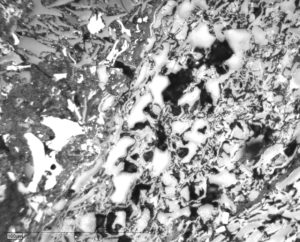No, not a dinosaur. Not an asteroid. But some kind of climatic condition that was none-to-good for organic material. For a very very long time.
Over the last year, my colleagues Prof Jian Shen and Prof Marvin Moroeng from China University of Mining and Technology (Xuzhou, China) and University of Johannesburg (South Africa), respectively, and I have been looking at a coal in Inner Mongolia. It is of Cretaceous age, is very thick (nearly 50 m) and occurs within the Yimin Formation. Basins in this part of

Tim Moore doing petrographic analysis (microscope use courtesy of Prof Joan Esterle, University of Queensland)
China/Mongolia/Russia have formed as a result of rifting and thus the sediments are filling graben structures. The coal seam’s distinguishing characteristic is that it seems to be full of oxidized material; not just a few intervals but the whole seam.
Our field and then laboratory assessment has supported that the paleomire that formed this coal, was extensively oxidized through out most of its accumulation. In the field large pieces of fusain (the technical term used for burned plant material found in coal) can be noted through all parts of the seam.

Photomicrograph of various oxidised material (“inertinite”) from a Cretaceous age coal from the Yimin Formation, Inner Mongolia, China. Scale at bottom is 100 µm.
When we put samples under the microscope we also see an abundance of oxidized material; some of that material is very well preserved wood while other material seems to have had some sort of secondary alteration. On average the seam is ~55% oxidized material, but one interval was an impressive 83%. Clearly a significant part of this oxidized material has resulted from combustion (i.e. fire) of plant material, but there may have been secondary processes also in action.
We are using a combination of field and laboratory techniques, such as organic petrography and ∂13C isotopes, to help decipher how the coal formed. We will submit an article for review in the next few weeks. Stay tuned!
*Apologies to both Shakespeare and Ray Bradbury



Trackbacks/Pingbacks
[…] blogs have also documented the early stages of this research (i.e.https://www.ciphercoal.com/something-wicked-this-way-comes-in-the-lower-cretaceous/, https://www.ciphercoal.com/not-freezing-in-inner-mongolia/, and […]